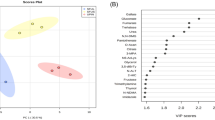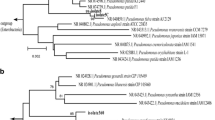Abstract
The ability was determined of the rumen ciliate Eudiplodinium maggii to utilize chitin from fungal cell wall. Cultivation experiments shoved that the population concentration (number of ciliates in vitro) was positively correlated with chitin doses. Cell extract prepared from the bacteria-free ciliates degraded colloidal chitin releasing 2.0 μmol reducing sugar per mg protein per h. End products of this reaction were chitotriose and N-acetylglucosamine. Incubation of the bacteria-free ciliates with chitin resulted in an increase in the concentration of acetic, propionic and butyric acids in the incubation medium. The production rate of total volatile fatty acids (VFA) by ciliates incubated with and without chitin was 45.0 and 30.5 pmol VFA per protozoan, respectively, the molar proportion of particular acids remaining unchanged.
Similar content being viewed by others
References
Bełżecki G., Miltko R., Michałowski T., Šimůnek J., Kopečný J.: Chitinolytic activity of sheep rumen ciliate Diploplastron affine. Folia Microbiol. 53, 201–203 (2008).
Bełżecki G., Newbold C.J., Mcewan N.R., Mcintosh F.M., Michałowski T.: Characterization of the amylolytic properties of the rumen ciliate protozoan Eudiplodinium maggii. J.Anim.Feed Sci.16, 590–606 (2007).
Coleman G.S., Davies J.I., Cash M.A.: The cultivation of rumen ciliates Epidinium ecaudatum and Polyplastron multivesiculatum in vitro. J.Gen.Microbiol.75, 509–521 (1972).
Lee S.S., Ha J.K., Cheng K.-J.: The effects of sequential inoculation of mixed rumen protozoa on the degradation of orchard grass cell walls by anaerobic fungus Anaeromyces mucronatus 543. Can. J. Microbiol.47, 754–760 (2001).
Michałowski T.: The synthesis and turnover of the cellular mater of ciliates in the rumen. Acta Protozool. 29, 47–72 (1990).
Michałowski T.: Digestion and fermentation of the microcrystalline cellulose by the rumen ciliate protozoan Eudiplodinium maggii. Acta Protozool. 36, 181–185 (1997).
Michałowski T., Muszyński P., Landa I.: Factors influencing the growth of rumen ciliates Eudiplodinm maggii in vitro. Acta Protozool. 25, 419–426 (1991).
Michałowski T., Szczepkowski P., Muszyński P.: The nutritive factors affecting the growth of the rumen ciliate Diploplastron affine in vitro. Acta Protozool. 25, 419–426 (1986).
Michałowski T., Harmeyer J., Bełżecki G.: The importance of washing the omasum for successful defaunation of sheep. J.Anim. Feed Sci. 8, 611–619 (1999).
Miller G.L., Blum R., Glennon E., Byrton A.: Measurement of carboxymetylcellulase activity. Analyt.Biochem. 2, 127–132 (1960).
Morgavi D.P., Sakurada M., Tomita Y., Onodera R.: Presence in rumen bacterial and protozoal populations of enzymes capable of degrading fungal cell walls. Microbiology140, 631–636 (1994).
Morgavi D.P., Sakurada M., Tomita Y., Onodera R.: Electrophoresis forms of chitinolytic and lysozyme activities in rumen protozoa. Curr.Microbiol.32, 115–118 (1996).
Orpin C.G.: The occurrence of chitin in the cell walls of the rumen organisms Neocallimastix frontalis, Piromonas communis and Sphaeromonas communis. J.Gen.Microbiol.99, 215–218 (1977).
Skujins J.J., Potgieter H.J., Alexander M.: Dissolution of fungal cell walls by a Streptomyces chitinase and β-(1→3)-glucanase. Arch.Biochem.Biophys. 111, 358–364 (1965).
Williams A.G., Coleman G.S.: The rumen microbial ecosystem, pp. 73–120 in P.N. Hobson, C.S. Stewart (Eds): The Rumen Protozoa. Blackie Academic and Professional, London 1997.
Xia G.Q., Jin C.S., Zhou J., Yang S.J., Zhang S.Z., Jin C.: A novel chitinase having a unique mode of action from Aspergillus fumigatus YJ-407. Eur.J.Biochem.268, 4079–4085 (2001).
Ziołecki A., Kwiatkowska E.: Gas chromatography of C1 to C5 fatty acids in rumen fluid and fermentation media. J.Chromatogr.80, 250–254 (1973).
Author information
Authors and Affiliations
Corresponding author
Rights and permissions
About this article
Cite this article
Miltko, R., Bełżecki, G., Kwiatkowska, E. et al. The ability of the rumen protozoan Eudiplodinium maggii to utilize chitin. Folia Microbiol 55, 349–351 (2010). https://doi.org/10.1007/s12223-010-0056-z
Received:
Revised:
Published:
Issue Date:
DOI: https://doi.org/10.1007/s12223-010-0056-z




